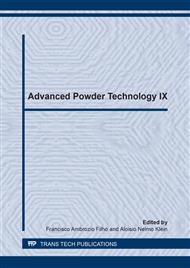p.491
p.496
p.501
p.507
p.512
p.518
p.524
p.530
p.535
Characterization of Titanium Powders Processed at Different Temperatures
Abstract:
Titanium is the most adequate metallic material for orthopedic or dental implants fabrication, due to a very favorable combination of properties, when compared with other metals, such as good corrosion resistance, good mechanical properties, relatively low density, elasticity modulus close to that of bone and good biocompatibility, which assures good adhesion/integration to bone. Powder metallurgy has been used for titanium based implants fabrication due to advantages such as the production of more complex shapes and reduction of machining operation. In this work, compacted pure titanium powders, consolidated by rolling at different temperatures, were characterized by means of optical microscopy, Field Emission Scanning Electron Microscopy (FESEM) with Electron Back Scattering Diffraction (EBSD) analysis, automatic image analysis and hardness tests. The hardness of rolled samples increased from 200 to 400oC , which indicated that 300 to 400°C is the most adequate temperature range for this processing route, since it allowed obtaining low porosity with satisfactory and relatively high hardness.
Info:
Periodical:
Pages:
512-517
Citation:
Online since:
December 2014
Keywords:
Price:
Сopyright:
© 2014 Trans Tech Publications Ltd. All Rights Reserved
Share:
Citation:


